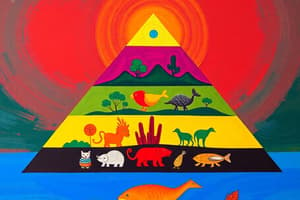Podcast
Questions and Answers
What does the pyramid of energy illustrate about energy transfer between trophic levels?
What does the pyramid of energy illustrate about energy transfer between trophic levels?
- Energy is always gained as it moves to higher trophic levels.
- Energy is only relevant at the producer level.
- Energy remains constant across all trophic levels.
- Energy loss occurs as it moves from lower to higher trophic levels. (correct)
What characterizes the process of ecological succession?
What characterizes the process of ecological succession?
- It only occurs in aquatic environments.
- It results in mature ecosystems that never change.
- It is an instantaneous change in ecosystem structure.
- It consists of predictable stages leading to a climax community. (correct)
In which scenario does primary succession occur?
In which scenario does primary succession occur?
- A grassland affected by grazing.
- A meadow undergoing seasonal changes.
- A forest recovering from a wildfire.
- A sand dune formed from deposits of sand. (correct)
What is the role of each successional stage in ecological succession?
What is the role of each successional stage in ecological succession?
What is the effect of disturbances in an ecosystem on secondary succession?
What is the effect of disturbances in an ecosystem on secondary succession?
Which of the following best describes the notable features of polar grasslands?
Which of the following best describes the notable features of polar grasslands?
Which of the following examples is correctly classified as a tropical desert?
Which of the following examples is correctly classified as a tropical desert?
Which feature distinguishes temperate deserts from tropical deserts?
Which feature distinguishes temperate deserts from tropical deserts?
What is a defining characteristic of permafrost?
What is a defining characteristic of permafrost?
Which of the following correctly describes a pond ecosystem?
Which of the following correctly describes a pond ecosystem?
Which type of ecological succession occurs on bare rock?
Which type of ecological succession occurs on bare rock?
What is the process called when nitrogen gas is converted into ammonia?
What is the process called when nitrogen gas is converted into ammonia?
Which component of nutrient cycling involves converting ammonia back into nitrogen gas?
Which component of nutrient cycling involves converting ammonia back into nitrogen gas?
During which stage of ecological succession do organisms establish themselves in a new environment?
During which stage of ecological succession do organisms establish themselves in a new environment?
What is a primary source of phosphorus found in nature?
What is a primary source of phosphorus found in nature?
Which process occurs when plants absorb nitrates from the soil to create proteins?
Which process occurs when plants absorb nitrates from the soil to create proteins?
What type of ecological succession occurs in areas with adequate moisture?
What type of ecological succession occurs in areas with adequate moisture?
What role do decomposers play in the nitrogen cycle?
What role do decomposers play in the nitrogen cycle?
What is the typical range of average temperatures in evergreen coniferous forests?
What is the typical range of average temperatures in evergreen coniferous forests?
Which of the following types of trees are dominant in evergreen coniferous forests?
Which of the following types of trees are dominant in evergreen coniferous forests?
In a typical tropical grassland, which animals are commonly found?
In a typical tropical grassland, which animals are commonly found?
What characterizes the canopy of evergreen coniferous forests?
What characterizes the canopy of evergreen coniferous forests?
Which soil condition is commonly found in evergreen coniferous forests?
Which soil condition is commonly found in evergreen coniferous forests?
Which factor primarily influences the climate of the temperate grassland?
Which factor primarily influences the climate of the temperate grassland?
What is a notable feature of tropical grasslands regarding rainfall?
What is a notable feature of tropical grasslands regarding rainfall?
Which of the following is NOT a primary consumer in grassland ecosystems?
Which of the following is NOT a primary consumer in grassland ecosystems?
Which of the following organisms is classified as a nekton?
Which of the following organisms is classified as a nekton?
What type of lake is characterized by high nutrient content?
What type of lake is characterized by high nutrient content?
Which zone of the ocean is known for having abundant sunlight and high photosynthetic activity?
Which zone of the ocean is known for having abundant sunlight and high photosynthetic activity?
What is a defining characteristic of mermictic lakes?
What is a defining characteristic of mermictic lakes?
Which of the following features is NOT typically associated with streams?
Which of the following features is NOT typically associated with streams?
Which type of lake has low nutrient content and is often clearer than other lake types?
Which type of lake has low nutrient content and is often clearer than other lake types?
In what stage does a river begin to demonstrate characteristics of a middle-aged river?
In what stage does a river begin to demonstrate characteristics of a middle-aged river?
Which of the following best describes the benthos in an aquatic ecosystem?
Which of the following best describes the benthos in an aquatic ecosystem?
Flashcards are hidden until you start studying
Study Notes
Ecological Pyramids
- Pyramid of Energy: Represents energy transfer across trophic levels; always upright due to energy loss at each level.
- Producers: Contribute the highest energy density at 2000 g/m².
- Consumers: Represent lower energy density at 675 g/m², reflecting energy inefficiency in the ecosystem.
Ecological Succession
- Definition: Gradual process of ecosystem change, leading to a stable climax community.
- Stages: Each phase, termed successional stages, prepares for the next community.
- Types of Succession:
- Primary Succession: Occurs on uncolonized areas (e.g., new rock faces).
- Secondary Succession: Follows disturbance in previously inhabited areas.
Succession Types by Environment
- Hydrarch (Hydrosere): Succession in aquatic environments (ponds, swamps).
- Mesarch (Mesosere): Characterized by adequate moisture.
- Xerarch (Xerosere): Describes succession on dry substrates like rocks (Lithosere) and sand (Psammosere).
Process of Ecological Succession
- Steps:
- Nudation: Initial habitat preparation.
- Invasion: Species migration, establishment, and aggregation.
- Competition: Interactions amongst species.
- Reaction: Changes in environment due to species presence.
- Stabilization: Development of a stable ecosystem.
Nutrient Cycles
-
Nitrogen Cycle:
- Nitrogen Fixation: Conversion of atmospheric nitrogen (N₂) into ammonia (NH₃).
- Nitrification: Ammonia conversion into nitrates (NO₃⁻) for plant absorption.
- Assimilation: Uptake by plants leading to nitrogen incorporation in animal tissues.
- Ammonification: Decomposition returns ammonia to soil.
- Denitrification: Conversion back to atmospheric nitrogen by denitrifying bacteria.
-
Phosphorus Cycle:
- Weathering: Release of phosphates from rock breakdown.
- Plant Absorption: Uptake of phosphates for essential biological processes.
- Animal Consumption: Ingestion of plants transfers phosphorus through the food chain.
Forest Ecosystems
- Characteristics of Boreal Forests:
- Climate: Cold temperatures ranging from -40°C to 20°C, with low precipitation (300-850 mm annually).
- Vegetation: Dominated by evergreen coniferous trees (spruce, fir, pine).
- Structure: Thick canopy reducing temperature fluctuations, leading to nutrient-poor acidic soils.
Grassland Ecosystems
- Tropical Grassland: Found near the equator; characterized by grassy dominance and seasonally heavy rainfall.
- Temperate Grassland: Lacks trees; experiences extreme temperatures from -40°C to 38°C.
- Polar Grassland: Harsh cold conditions with unique fauna, found in Arctic regions.
Desert Ecosystems
- Types:
- Tropical Deserts: Hottest and driest; sporadic rainfall.
- Temperate Deserts: Colder climates; floor covered in rocks.
- Cold Deserts: Experience hot summers and extremely cold winters.
Aquatic Ecosystems
- Pond Ecosystem: Small, stagnant freshwater bodies with interdependent organisms.
- Lake Ecosystem: Defined by biological zonation (epilimnion, hypolimnion) and diverse aquatic life.
- Stream Ecosystem: Characterized by flowing water, different microhabitats, and adaptive flora and fauna.
- Marine Ecosystems: Broad diversity of life, influenced by ocean zones (coastal, open sea, euphotic, bathyal, abyssal).
Review Questions
- Niche: Natural habitat of an organism.
- Energy Requirement: Primary producers require the most energy in the ecosystem.
Studying That Suits You
Use AI to generate personalized quizzes and flashcards to suit your learning preferences.




